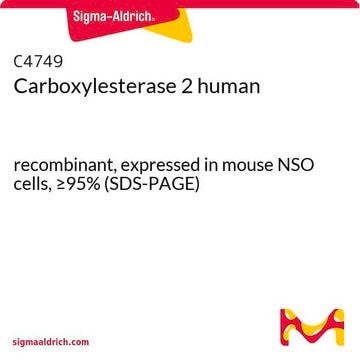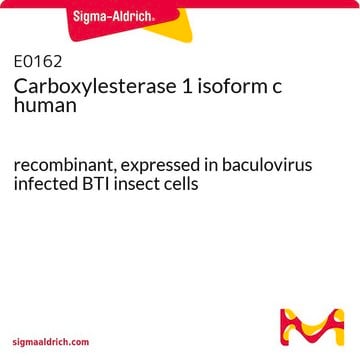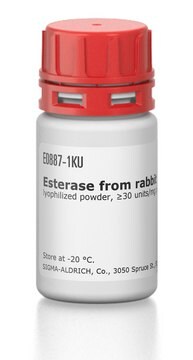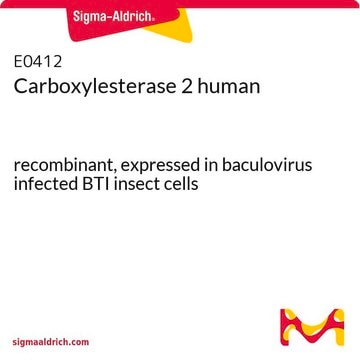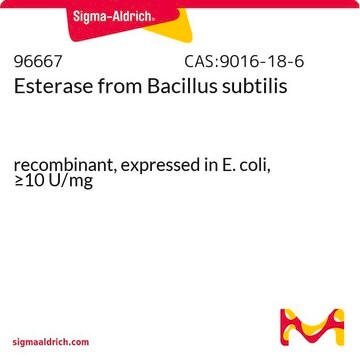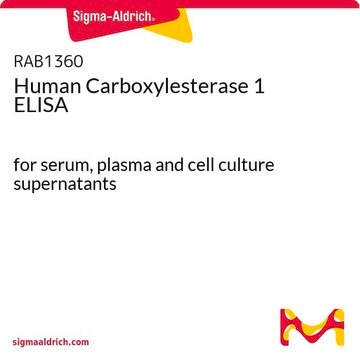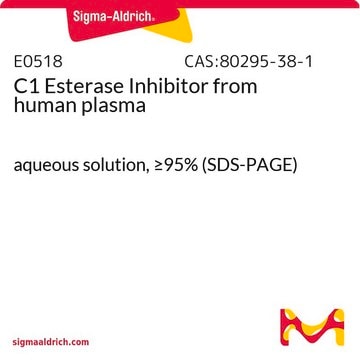E0287
Carboxylesterase 1 isoform b human
recombinant, expressed in baculovirus infected BTI insect cells
Synonym(s):
Carboxylesterase 1 human, carboxylesterase, esterase
Sign Into View Organizational & Contract Pricing
All Photos(1)
About This Item
Recommended Products
recombinant
expressed in baculovirus infected BTI insect cells
Quality Level
form
liquid
specific activity
≥500 units/mg protein
concentration
5 mg/mL
weight
(0.5 ml)
shipped in
dry ice
storage temp.
−70°C
Looking for similar products? Visit Product Comparison Guide
General description
Carboxylesterase (CE) belongs to serine hydrolase family. It is widely present in the human body. Five isoforms of carboxylesterase is present in humans. It is encoded by CES1 gene mapped to 16q22.2 in human chromosome.
Carboxylesterase 1 is a member of a large multigene carboxylesterase family. These enzymes are responsible for the hydrolysis of ester- and amide-bond-containing drugs such as cocaine and heroin. They also hydrolyze long-chain fatty acid esters and thioesters. This enzyme is known to hydrolyze aromatic and aliphatic esters and is necessary for cellular cholesterol esterification. It may also play a role in detoxification in the lung and/or protection of the central nervous system from ester or amide compounds.
Application
Carboxylesterase 1 isoform b human has been used in the reaction to convert Amplex red to resorufin in horse radish peroxidase and oxygen independent manner. It has also been used in the development of an emission ratiometric two-photon probe (SE1) for quantitation in situ.
Delivers high catalytic activity, ideal for robust high-throughput screening assays including drug-drug interaction studies, and pharmacokinetic studies for evaluating pro-drugs and non-CYP pathways of elimination.
Biochem/physiol Actions
Carboxylesterase (CE) is implicated in drug metabolism in liver and hepatic steatosis. Deficiency of CE in humans causes obesity, hyperlipidemia, insulin insensitivity, and cancer.
Unit Definition
One unti will hydrolyze one nanomole of 4-nitrophenyl acetate per minute at pH 7.4 at 37°C
Signal Word
Danger
Hazard Statements
Precautionary Statements
Hazard Classifications
Resp. Sens. 1
Storage Class Code
11 - Combustible Solids
WGK
WGK 1
Flash Point(F)
Not applicable
Flash Point(C)
Not applicable
Certificates of Analysis (COA)
Search for Certificates of Analysis (COA) by entering the products Lot/Batch Number. Lot and Batch Numbers can be found on a product’s label following the words ‘Lot’ or ‘Batch’.
Already Own This Product?
Find documentation for the products that you have recently purchased in the Document Library.
Customers Also Viewed
Non classical monocytes levels, increased by subcutaneous fat-Secretome, are associated with less Rehospitalization after heart failure admission
Eiras S, et al.
Journal of Cardiovascular Translational Research, 10(1), 16-26 (2017)
Carboxylesterase converts Amplex red to resorufin: Implications for mitochondrial H2O2 release assays
Miwa S, et al.
Free Radical Biology & Medicine, 90, 173-183 (2016)
A carboxylesterase-selective ratiometric fluorescent two-photon probe and its application to hepatocytes and liver tissues
Park SJ, et al.
Chemical Science, 7(6), 3703-3709 (2016)
XieMei Tang et al.
Critical reviews in eukaryotic gene expression, 22(3), 179-187 (2012-11-13)
Tuberculosis remains one of the most prevalent and deadly infectious diseases, largely due to the emergence of multidrug-resistant and extensive drug-resistant Mycobacterium tuberculosis, especially the coinfection with HIV. Mycobacterium Ag85 complex (Ag85A, B, and C), with a carboxylesterase consensus sequence
Zhe-Yi Hu et al.
Analytical and bioanalytical chemistry, 405(5), 1695-1704 (2012-12-15)
Dabigatran etexilate (DABE) is an oral prodrug that is rapidly converted by esterases to dabigatran (DAB), a direct inhibitor of thrombin. To elucidate the esterase-mediated metabolic pathway of DABE, a high-performance liquid chromatography/mass spectrometry based metabolite identification and semi-quantitative estimation
Our team of scientists has experience in all areas of research including Life Science, Material Science, Chemical Synthesis, Chromatography, Analytical and many others.
Contact Technical Service